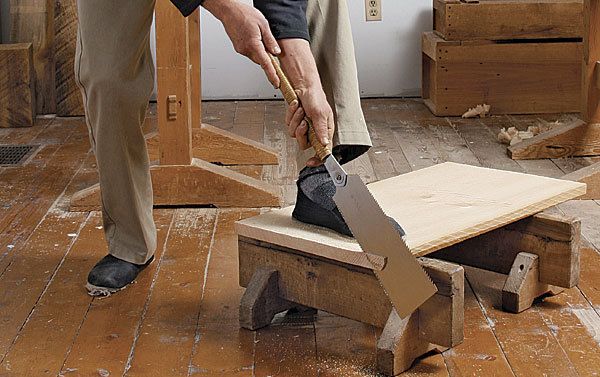The power of the pull stroke
A custom furniture maker shares his passion for Japanese handsaws.

Synopsis: Andrew Hunter taught himself to use Japanese pullsaws. Admittedly not a purist when it comes to using Japanese tools, his techniques are a mixture of Japanese and Western ways of working. Here, he shares some of his techniques for ripping, crosscutting, posture and workholding, and buying Japanese saws. He also offers guidance on which saws to buy first, including three versatile saws that should take care of most of your sawing tasks.
I must admit I’m reluctant to present myself as an authority on Japanese saws. I’ve never been to Japan, and I’ve never trained with a Japanese woodworker. If I have an excuse for writing about Japanese saws it could be simply that I love using them. Or that my perspective might be helpful: I’m an American who taught myself to use Japanese tools by watching and listening to and learning from the tools themselves.
My first experience as a woodworker was in my senior year of college, when I built myself a bookshelf. Made with a circular saw and a handful of nails, it wasn’t the finest thing, but I enjoyed making it so much I was convinced I’d found my career. Soon afterward I bought my first collection of hand tools at the local hardware store—a Stanley handplane, a set of blue-handled Marples chisels, and a doublesided Japanese saw. It was a mixed bag of traditions: American, English, Japanese. I opened every book on woodworking I could get my hands on, learning from anybody who had something to offer.
Eventually I came across Toshio Odate’s book, Japanese Woodworking Tools: Their Tradition, Spirit and Use (Linden Publishing, reprinted 1998), and it resonated right through me. I was immediately drawn to the beauty of the tools, and Odate’s stories of his apprenticeship in Japan and his crystal-clear explanations of Japanese tools and traditions inspired me enormously. I was in my 20s, searching out what I wanted to do in this world, and it was his book, in part, that led me to create a self-directed apprenticeship to teach myself to use Japanese tools. Most important, Odate’s book taught me to be patient—to master steps 1 through 9 before attempting step 10.
Having acquired a basic understanding of Japanese tools from reading, I taught myself to use them through trial and error. I paid attention to how the wood responded to the tools and how the tools responded to me; eventually the three of us learned to get along.
As much as I love Japanese tools and techniques, I’m not a purist. My methods are a mixture of Japanese and Western ways of working. Japanese craftsmen may be comfortable working on the floor, for instance, but I was uncomfortable trying to adapt to this. As a result, the postures I use, along with many of my techniques, are a compromise between the advantages of the Japanese approach and the ability of a Western-trained body and mind to adapt.
For the full article, download the PDF below:
Fine Woodworking Recommended Products

Bahco 6-Inch Card Scraper

Stanley Powerlock 16-ft. tape measure

Marking knife: Hock Double-Bevel Violin Knife, 3/4 in.








Log in or create an account to post a comment.
Sign up Log in